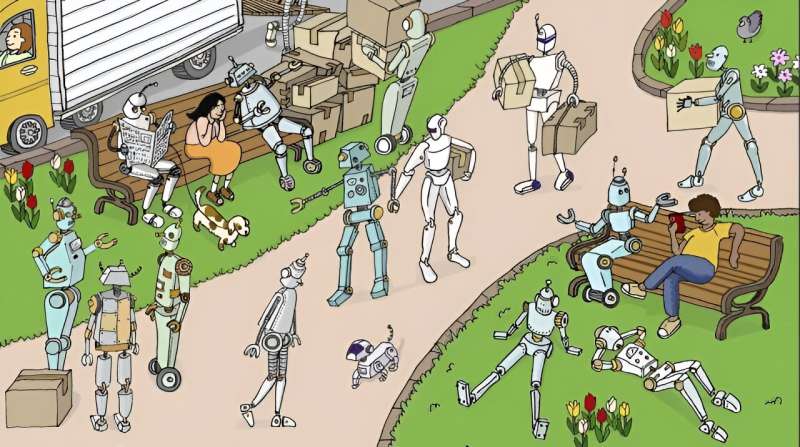April 6, 2024 report
This article has been reviewed according to Science X's editorial process and policies. Editors have highlighted the following attributes while ensuring the content's credibility:
fact-checked
trusted source
proofread
Saturday Citations: AI and the prisoner's dilemma; stellar cannibalism; evidence that EVs reduce atmospheric CO₂

While I was assembling and formatting all these links, we had a 4.8-magnitude earthquake here on the East Coast, so apologies in advance for any misaligned text. This week: Gravitationally accelerated stars! AIs that exhibit cooperative and selfish behaviors! And another edition of "Would You Eat This?"
Cooperators betrayed
Japanese researchers developed an AI system that exhibits a diverse range of personality traits and switches between selfish or cooperative behaviors depending on context. Using the prisoner's dilemma, instances of the AI system chose to cooperate or defect from an AI partner; if they cooperate during the game, both systems received four virtual dollars. If one defected while the other cooperated, the defector received $5 and the cooperator received nothing.
The researchers developed multiple AIs that evolved based on repetitions of the game, ultimately displaying cooperative or selfish behaviors over successive generations. "Our experiments provide fascinating insights into the evolutionary dynamics of personality traits in AI agents. We observed the emergence of both cooperative and selfish personality traits within AI populations, reminiscent of human societal dynamics," said Professor Reiji Suzuki from Nagoya University's Graduate School of Informatics.
However, Suzuki also notes that over time, highly cooperative groups were eventually supplanted by generations of egocentric models. The researchers believe the study provides insights that could contribute to the future development of beneficial AI.
Air better
Ronald Cohen, an atmospheric chemist from the University of California, Berkeley, reports that an extensive CO2-monitoring network of sensors he deployed around the Bay Area may have recorded reductions in carbon emissions caused by the adoption of electric vehicles. The network is a proof-of-concept project to monitor urban areas and identify neighborhoods affected by high emissions with previously impossible granularity.
Between 2018 and 2022, the network's sensors recorded an overall decrease in carbon emissions of 1.8% annually, which translates to a 2.6% annual drop in vehicle emission rates. The researchers note that California has a particularly high adoption rate for electric vehicles, making it an ideal testbed for the impact of the energy transition.
"We show from atmospheric measurements that adoption of electric vehicles is working, that it's having the intended effect on CO2 emissions," Cohen said. They also point out that the reductions the network reports need to double in order to reach California's target goal of net zero emissions by 2045.
Neighborhood bad
The immediate neighborhood of Sagittarius A*, the supermassive black hole at the center of the Milky Way galaxy (and my heart), has inordinately heavy traffic due to the immense gravity and dense local population of stars. Researchers at Northwestern University observed that a higher-than-expected number of these stars appear to be extremely youthful, like Paul Rudd, and built a model of the system to derive some deductions about this stellar population.
Among their findings, they determined that stars appeared to be younger because they violently consumed their neighbors. Close to the black hole—within about 0.01 parsecs—stars are accelerated to orbits of thousands of kilometers per second. And the sheer number of stars in the region makes collisions inevitable. Sometimes stars simply graze one another.
"They whack into each other and keep going," says Sanaea C. Rose, who led the research. In this scenario, the stars can lose their outer layers and keep on trucking. Further out from the black hole, at more leisurely orbits, the stars don't have the momentum to escape each other and merge, becoming more massive. After successive collisions and mergers, these stars can appear to be younger than their actual age, like Paul Rudd, but ultimately have shorter lifespans.
Fish gross
Last week in Saturday Citations, we linked a story about researchers who studied the drinkability of 100-year-old milk. This week on "Would You Eat This?," researchers at the Peabody Museum of Natural History at Yale University studied 42-year-old cans of salmon. The cans contain filets from four species caught over a 42-year period in the Gulf of Alaska and Bristol Bay.
Wait, don't close the tab yet, this gets even more appetizing: The researchers dissected the filets to count the number of anisakid roundworm parasites, which is apparently something you could do at home yourself with canned salmon or even fresh salmon from the fish counter.
The parasites are killed while cooking and canning, and pose no threat to human health, although there is no information about their flavor profile in the article. Chelsea Wood, a UW associate professor of aquatic and fishery sciences, said, "Everyone assumes that worms in your salmon is a sign that things have gone awry. But the anisakid life cycle integrates many components of the food web. I see their presence as a signal that the fish on your plate came from a healthy ecosystem."
© 2024 Science X Network





















